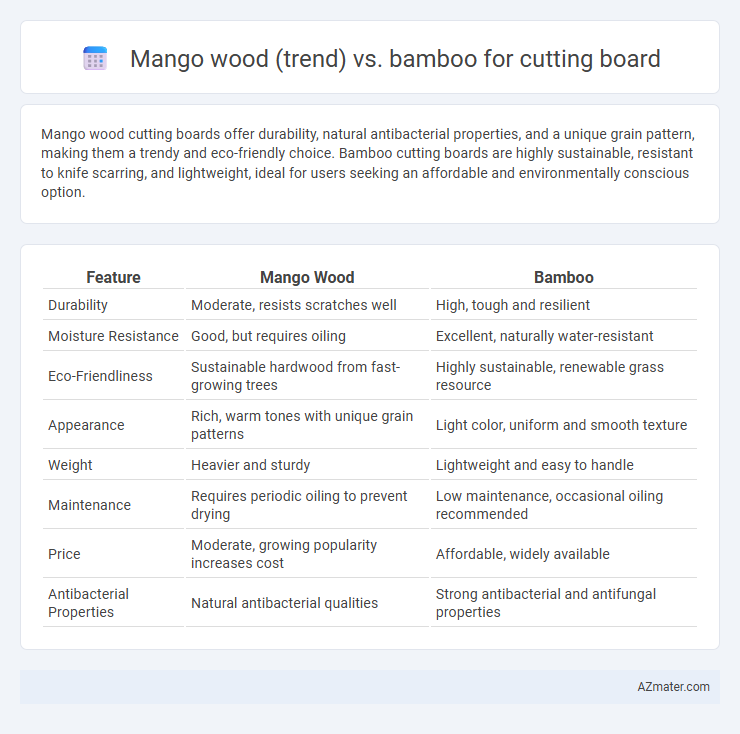Mango wood cutting boards offer durability, natural antibacterial properties, and a unique grain pattern, making them a trendy and eco-friendly choice. Bamboo cutting boards are highly sustainable, resistant to knife scarring, and lightweight, ideal for users seeking an affordable and environmentally conscious option.
Table of Comparison
| Feature | Mango Wood | Bamboo |
|---|---|---|
| Durability | Moderate, resists scratches well | High, tough and resilient |
| Moisture Resistance | Good, but requires oiling | Excellent, naturally water-resistant |
| Eco-Friendliness | Sustainable hardwood from fast-growing trees | Highly sustainable, renewable grass resource |
| Appearance | Rich, warm tones with unique grain patterns | Light color, uniform and smooth texture |
| Weight | Heavier and sturdy | Lightweight and easy to handle |
| Maintenance | Requires periodic oiling to prevent drying | Low maintenance, occasional oiling recommended |
| Price | Moderate, growing popularity increases cost | Affordable, widely available |
| Antibacterial Properties | Natural antibacterial qualities | Strong antibacterial and antifungal properties |
Mango Wood Cutting Boards: Rising Trend in Kitchenware
Mango wood cutting boards are gaining popularity due to their durability, attractive grain patterns, and eco-friendly qualities derived from sustainable mango tree cultivation. Unlike bamboo, which is grass and can be prone to splintering, mango wood offers a harder, denser surface that resists knife marks and bacterial buildup. The trend towards mango wood cutting boards reflects growing consumer interest in unique, sustainable kitchenware combining functionality with natural aesthetic appeal.
Bamboo Cutting Boards: Established Eco-Friendly Choice
Bamboo cutting boards have become an established eco-friendly choice due to their rapid renewability, durability, and natural antimicrobial properties, making them ideal for sustainable kitchens. Unlike mango wood, which is harvested from slower-growing trees, bamboo is a fast-growing grass that regenerates quickly without requiring replanting, reducing environmental impact. Bamboo's dense fiber structure resists deep knife grooves and bacterial buildup, ensuring long-lasting hygiene compared to traditional hardwood boards.
Sustainability: Mango Wood vs Bamboo Production
Mango wood cutting boards are praised for utilizing wood from trees that no longer produce fruit, reducing waste and promoting eco-friendly sourcing. Bamboo grows rapidly and requires minimal water, making bamboo cutting boards a highly renewable and sustainable option. Compared to mango wood, bamboo's faster harvest cycle and lower environmental impact in production often position it as a more sustainable material for cutting boards.
Durability and Strength Comparison
Mango wood cutting boards are prized for their dense grain and natural hardness, offering excellent durability and resistance to knife marks, making them ideal for heavy-duty kitchen use. Bamboo cutting boards are known for their impressive strength-to-weight ratio, with tightly packed fibers that provide durability while being eco-friendly and less prone to warping. Compared to bamboo, mango wood typically offers superior longevity and a more robust cutting surface, though bamboo's lighter weight and sustainability appeal remain significant advantages.
Knife-Friendliness: Which Surface is Gentler?
Mango wood cutting boards are known for their slightly softer texture, which helps preserve knife sharpness by reducing blade dulling over time. Bamboo surfaces, while durable and eco-friendly, tend to be harder and can cause knives to dull more quickly due to their dense, fibrous structure. Choosing mango wood offers a gentler cutting surface ideal for maintaining knife edges during regular kitchen use.
Aesthetic Appeal: Grain and Color Differences
Mango wood cutting boards feature a rich, warm orange-brown color with distinctive swirling grain patterns that enhance their aesthetic appeal, adding a rustic yet elegant touch to kitchen decor. Bamboo cutting boards display a lighter, more uniform pale yellow to golden hue with straight, linear grain lines, offering a modern and clean look. The contrasting grain complexity and color depth between mango wood and bamboo cater to diverse design preferences, making mango wood favored for a more vibrant, natural appearance while bamboo suits minimalist, contemporary styles.
Maintenance and Care: Which is Easier?
Mango wood cutting boards require regular oiling to prevent cracking and maintain durability, but they resist water absorption well, making maintenance straightforward. Bamboo cutting boards are naturally resistant to moisture and bacteria, needing less frequent oiling but can be prone to splintering if not properly cared for. Overall, bamboo offers easier maintenance due to its hard, water-resistant surface, while mango wood demands more consistent conditioning to remain in optimal condition.
Price and Accessibility Analysis
Mango wood cutting boards are generally more affordable than bamboo, with prices ranging from $15 to $40 depending on size and craftsmanship, making them accessible for budget-conscious consumers. Bamboo cutting boards tend to cost between $20 and $50, reflecting their eco-friendly appeal and renewable sourcing. Availability of mango wood boards is widespread in regions where mango trees are common, while bamboo boards benefit from global distribution due to bamboo's rapid growth and sustainability.
Potential Health Concerns: Antibacterial Properties
Mango wood cutting boards offer natural antibacterial properties due to their dense grain structure, reducing the risk of bacterial contamination during food preparation. Bamboo cutting boards are highly resistant to moisture and bacterial growth, attributed to their silica content and tight fibers, making them a hygienic choice for kitchens. Both materials are sustainable and durable, but bamboo's faster regeneration and inherent antimicrobial qualities make it a preferred option for minimizing potential health concerns.
Final Verdict: Mango Wood or Bamboo for Your Kitchen?
Mango wood cutting boards offer a dense, durable surface with natural antibacterial properties, making them resistant to knife marks and warping. Bamboo cutting boards are eco-friendly, lightweight, and highly renewable, boasting superior hardness but tend to be more prone to cracking over time. Choosing between mango wood and bamboo depends on whether you prioritize durability and aesthetics or sustainability and maintenance ease for your kitchen.

Infographic: Mango wood (trend) vs Bamboo for Cutting board
 azmater.com
azmater.com